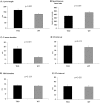Total beta-adrenoceptor knockout slows conduction and reduces inducible arrhythmias in the mouse heart
- PMID: 23133676
- PMCID: PMC3486811
- DOI: 10.1371/journal.pone.0049203
Total beta-adrenoceptor knockout slows conduction and reduces inducible arrhythmias in the mouse heart
Abstract
Introduction: Beta-adrenoceptors (β-AR) play an important role in the neurohumoral regulation of cardiac function. Three β-AR subtypes (β(1), β(2), β(3)) have been described so far. Total deficiency of these adrenoceptors (TKO) results in cardiac hypotrophy and negative inotropy. TKO represents a unique mouse model mimicking total unselective medical β-blocker therapy in men. Electrophysiological characteristics of TKO have not yet been investigated in an animal model.
Methods: In vivo electrophysiological studies using right heart catheterisation were performed in 10 TKO mice and 10 129SV wild type control mice (WT) at the age of 15 weeks. Standard surface ECG, intracardiac and electrophysiological parameters, and arrhythmia inducibility were analyzed.
Results: The surface ECG of TKO mice revealed a reduced heart rate (359.2±20.9 bpm vs. 461.1±33.3 bpm; p<0.001), prolonged P wave (17.5±3.0 ms vs. 15.1±1.2 ms; p = 0.019) and PQ time (40.8±2.4 ms vs. 37.3±3.0 ms; p = 0.013) compared to WT. Intracardiac ECG showed a significantly prolonged infra-Hisian conductance (HV-interval: 12.9±1.4 ms vs. 6.8±1.0 ms; p<0.001). Functional testing showed prolonged atrial and ventricular refractory periods in TKO (40.5±15.5 ms vs. 21.3±5.8 ms; p = 0.004; and 41.0±9.7 ms vs. 28.3±6.6 ms; p = 0.004, respectively). In TKO both the probability of induction of atrial fibrillation (12% vs. 24%; p<0.001) and of ventricular tachycardias (0% vs. 26%; p<0.001) were significantly reduced.
Conclusion: TKO results in significant prolongations of cardiac conduction times and refractory periods. This was accompanied by a highly significant reduction of atrial and ventricular arrhythmias. Our finding confirms the importance of β-AR in arrhythmogenesis and the potential role of unspecific beta-receptor-blockade as therapeutic target.
Conflict of interest statement
Figures






Similar articles
-
Cardiac conduction disturbances and differential effects on atrial and ventricular electrophysiological properties in desmin deficient mice.J Interv Card Electrophysiol. 2010 Aug;28(2):71-80. doi: 10.1007/s10840-010-9482-8. J Interv Card Electrophysiol. 2010. PMID: 20390331
-
Deficiency of cyclase-associated protein 2 promotes arrhythmias associated with connexin43 maldistribution and fibrosis.Arch Med Sci. 2016 Feb 1;12(1):188-98. doi: 10.5114/aoms.2015.54146. Epub 2016 Feb 2. Arch Med Sci. 2016. PMID: 26925136 Free PMC article.
-
Cardiac Rac1 overexpression in mice creates a substrate for atrial arrhythmias characterized by structural remodelling.Cardiovasc Res. 2010 Aug 1;87(3):485-93. doi: 10.1093/cvr/cvq079. Epub 2010 Mar 7. Cardiovasc Res. 2010. PMID: 20211865
-
Pathophysiology of arrhythmias: clinical electrophysiology.Am Heart J. 1983 Oct;106(4 Pt 2):812-28. doi: 10.1016/0002-8703(83)90004-2. Am Heart J. 1983. PMID: 6351576 Review.
-
Mechanisms of atrial fibrillation: rotors, ionic determinants, and excitation frequency.Cardiol Clin. 2014 Nov;32(4):495-506. doi: 10.1016/j.ccl.2014.07.001. Epub 2014 Oct 23. Cardiol Clin. 2014. PMID: 25443232 Free PMC article. Review.
Cited by
-
Fluoxetine promotes IL-10-dependent metabolic defenses to protect from sepsis-induced lethality.Sci Adv. 2025 Feb 14;11(7):eadu4034. doi: 10.1126/sciadv.adu4034. Epub 2025 Feb 14. Sci Adv. 2025. PMID: 39951524 Free PMC article.
-
Association of Guideline-Based Medical Therapy with Malignant Arrhythmias and Mortality among Heart Failure Patients Implanted with Cardioverter Defibrillator (ICD) or Cardiac Resynchronization-Defibrillator Device (CRTD).J Clin Med. 2021 Apr 17;10(8):1753. doi: 10.3390/jcm10081753. J Clin Med. 2021. PMID: 33920719 Free PMC article.
-
let-7e replacement yields potent anti-arrhythmic efficacy via targeting beta 1-adrenergic receptor in rat heart.J Cell Mol Med. 2014 Jul;18(7):1334-43. doi: 10.1111/jcmm.12288. Epub 2014 Apr 24. J Cell Mol Med. 2014. PMID: 24758696 Free PMC article.
-
High fat diet induced alterations of atrial electrical activities in mice.Am J Cardiovasc Dis. 2016 Mar 1;6(1):1-9. eCollection 2016. Am J Cardiovasc Dis. 2016. PMID: 27073731 Free PMC article.
-
Impact of Intracardiac Neurons on Cardiac Electrophysiology and Arrhythmogenesis in an Ex Vivo Langendorff System.J Vis Exp. 2018 May 22;(135):57617. doi: 10.3791/57617. J Vis Exp. 2018. PMID: 29889210 Free PMC article.
References
-
- Dixon RA, Kobilka BK, Strader DJ, Benovic JL, Dohlman HG, et al. (1986) Cloning of the gene and cDNA for mammalian beta-adrenergic receptor and homology with rhodopsin. Nature 321: 75–79. - PubMed
-
- Emorine LJ, Marullo S, Briend-Sutren MM, Patey G, Tate K, et al. (1989) Molecular characterization of the human beta 3-adrenergic receptor. Science 245: 1118–1121. - PubMed
-
- Wallukat G (2002) The beta-adrenergic receptors. Herz 27: 683–690. - PubMed
MeSH terms
Substances
LinkOut - more resources
Full Text Sources
Medical
Molecular Biology Databases
Research Materials

